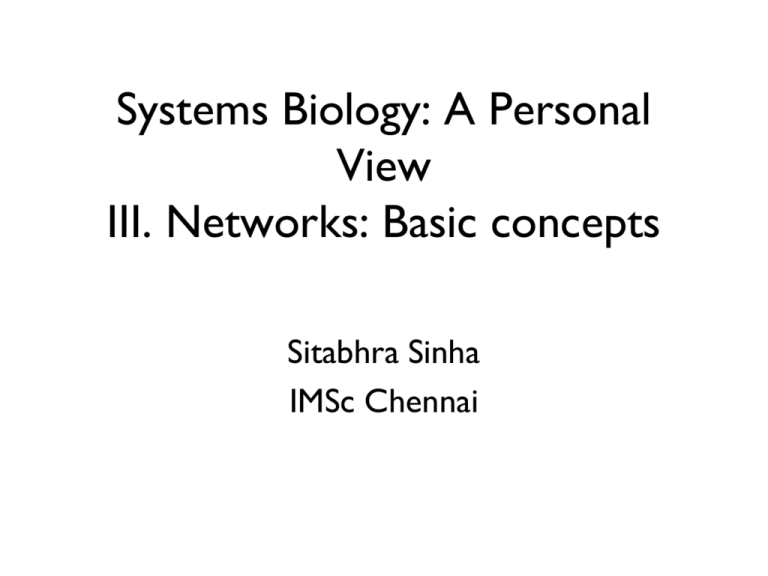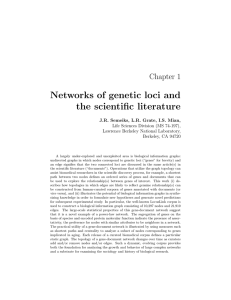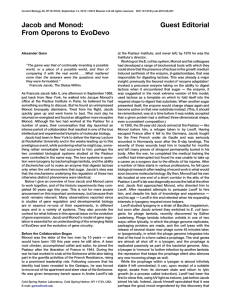Systems Biology: A Personal View III. Networks: Basic concepts
advertisement

Systems Biology: A Personal
View
III. Networks: Basic concepts
Sitabhra Sinha
IMSc Chennai
Ubiquity of Networks
Networks appear at all scales in biology
Proteins
Epidemics
Neuronal
Intra-cellular
communication
signalling
Food webs
10-9 m
10-6 m
10-3 m
1m
103 m
106 m
Molecules
Cells
Organisms Populations Ecologies
Nonlinear dynamics,
Game-theory strategies
Complexity of dynamics
Nodal
dynamics
Synchronization,
Consensus,
Cooperation
Dynamics on
Complex Networks
Complex
Networks
Ordering,
Diffusion,
Contagion Spreading
Complexity of interconnection
What is a network ?
Components = Nodes or Vertices
Nodes V={vi}
Links A={aij}
Interactions = Links or Edges
System = Network or Graph
Network structure is defined by adjacency matrix A
Aij = 1, if a link exists between i and j ( i)
= 0, otherwise
Network
What is a complex network ?
Other than regular networks (d-dimensional lattice) or
homogeneous random networks
Using the concept of networks:
From the 7 bridges of Konigsberg…
Source: Wikipedia
Problem: to find a walk through the city that
would cross each bridge once and only once.
Euler: the problem has no solution.
Source: Wikipedia
Leonard Euler (1707-1783)
Led to foundation of Graph theory: the study of mathematical structures called
graphs that model pairwise relations between objects
Using the concept of networks:
…to searching the World Wide Web
When the World Wide Web
(WWW) was first proposed,
it was widely assumed that its
utility was limited because it
would be impossible to
efficiently access the vast
quantity of information
distributed throughout the
entire network
Like searching for a needle in a
haystack most of the time
what you will find will be
completely irrelevant to what
you want !
Growth of number of web pages
between 1991-2007
Source:www.useit.com/alertbox/web-growth.html
Using the theory of networks
Google’s answer to data deluge
Manually indexed search engines were clearly
incapable of handling the exponentially
increasing amount of information in the
web…
until Google came up with an efficient
automated search algorithm that
weights the importance of each page
according to how many other pages are
pointing to it
Source: Wikipedia
• The page rank algorithm is directly inspired by the graph
theoretic concept of node centrality
• importance of a node measured in terms of how extensively it is
connected to other important (i.e., having high centrality) nodes.
Thinking about biological problems in
terms of networks
Example:
The system of genes in a cell that switch
each other ON/OFF resulting in a
cellular phenotype
Network of genes
controlling each other
Overview of prokaryotic transcription
regulation
Genes
TFs
Jacques Monod
(1910 – 1976 )
Wikipedia
Jacob & Monod: Explained the genetic regulation of
enzyme synthesis with their work on lac operon in
E coli
www.pasteur.fr
www.discoveryandinnovation.com
1965
Francois Jacob
(1920 – 2013)
Led to the idea of a bipartite
network of genes and
transcription factors that regulate
the expression (switching
ON/OFF) of genes: collective
activity of the network –
expression of different proteins –
in a cell differs depending on the
cell type (e.g., neuron vs muscle
cell)
Random Boolean Network
www.anisn.it
Model for explaining how the collective switching of genes
can lead to different cellular phenotypes
S A Kauffman (1969) Metabolic stability and epigenesis in randomly
constructed genetic nets. Journal of Theoretical Biology, 22:437-467.
N Boolean variables each of whose states are determined by a
boolean function taking inputs from a subset of size K variables
Stuart Kauffman
(1939 - )
The set of
functions
defines a
directed
network on
N nodes
2N possible
network
states for
binary
variables
wiki.cas-group.net
Kauffman, Scientific American (1991)







